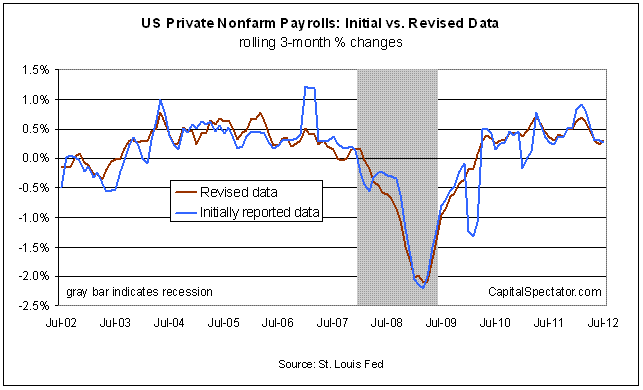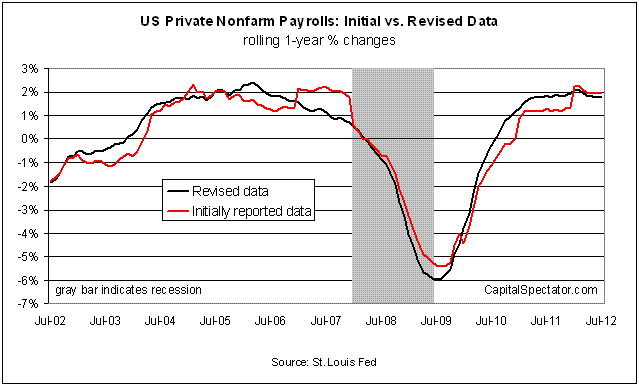The ongoing potential for data revisions to create chaos in the best-laid plans of analysis is no trivial matter. It’s a perennial challenge and one that requires constant attention. But it needn’t be fatal in the essential task of reading the numbers for clues about where the economy’s headed. There are no complete solutions, but there are techniques to keep this hazard from turning an otherwise reasonably designed forecast into trash.
One approach I use begins by recognizing that there can be a lot more noise in the short term numbers compared with longer-term data. For instance, if you’re analyzing private-sector non-farm payrolls for insight on the business cycle, the potential for getting whipsawed by revisions for, say, 3-month percentage changes can be quite high. That doesn't mean we should ignore shorter-term comparisons, but it's a mistake to rely on them alone.
Accordingly, we can manage revision risk to a degree by focusing on year-over-year changes as well, a technique that also minimizes seasonal distortions. If you’re comparing the latest data point to its counterpart from a year ago, the earlier number is less likely to be revised after 12 months. Even if it is, history shows that the differences between initial estimates and revisions tend to be less volatile through time vs. looking at shorter-term comparisons.
As an illustration, consider private nonfarm payrolls on rolling 3-month percentage-change basis. Let’s compare those changes in terms of the initially reported data (via the ALFRED database at the St. Louis Fed) and the revised data (as reported by FRED). 
As you can see in the chart above, the difference between the initial estimate and its revision can be rather dramatic at times. In early 2010, for instance, the initial data was wildly misleading relative to the revised data that was reported later. Such differences tend to less extreme and therefore less troublesome in year-over-year comparisons, as the second chart below illustrates. Yes, revisions can be a minimal problem for short-term comparisons at times, but you never know when a big revision is going to hit you over the head.
The higher level of revision risk in the shorter term applies to many data series, which is why it's important to look at year-over-year changes to keep this problem from spinning out of control. It's not a perfect solution, however. Revisions still bedevil annual comparisons. That inspires adding another layer of defense by combining a carefully selected mix of indicators in order to keep a lid on the noise from any one set of numbers.
A third treatment for managing revision risk is looking at the aggregate of annual changes for a broad set of indicators through the filter of a diffusion index. In other words, focus on the binary signal of the indicators in terms of the annual trend: is the indicator rising or falling? Combining these signals into a single diffusion index, which is the basis for the Capital Spectator Economic Trend Index, provides a valuable signal for assessing the business cycle overall and estimating recession risk in particular.
To be sure, perfection still eludes us. It always does in matters of macro analysis, which is why it's critical to evaluate the business cycle from several perspectives, with different methodologies and different indicators. In sum, developing a solid read on the business cycle, which can only be estimated, takes a fair amount of work.
That said, the various risks that cloud our capacity for looking ahead aren't absolute, at least not always. There are usually partial solutions to consider. That's not always clear when some analysts talk of a given risk in the interest of rationalizing their forecast du jour. Yes, revisions can be a problem—a big problem if you're clueless. Fortunately, there are ways to deal with revisions to keep them from turning an otherwise reasonable forecast into garbage.
- English (UK)
- English (India)
- English (Canada)
- English (Australia)
- English (South Africa)
- English (Philippines)
- English (Nigeria)
- Deutsch
- Español (España)
- Español (México)
- Français
- Italiano
- Nederlands
- Português (Portugal)
- Polski
- Português (Brasil)
- Русский
- Türkçe
- العربية
- Ελληνικά
- Svenska
- Suomi
- עברית
- 日本語
- 한국어
- 简体中文
- 繁體中文
- Bahasa Indonesia
- Bahasa Melayu
- ไทย
- Tiếng Việt
- हिंदी
Managing Revision Risk
Published 09/26/2012, 12:44 AM
Updated 07/09/2023, 06:31 AM
Managing Revision Risk
Latest comments
Loading next article…
Install Our App
Risk Disclosure: Trading in financial instruments and/or cryptocurrencies involves high risks including the risk of losing some, or all, of your investment amount, and may not be suitable for all investors. Prices of cryptocurrencies are extremely volatile and may be affected by external factors such as financial, regulatory or political events. Trading on margin increases the financial risks.
Before deciding to trade in financial instrument or cryptocurrencies you should be fully informed of the risks and costs associated with trading the financial markets, carefully consider your investment objectives, level of experience, and risk appetite, and seek professional advice where needed.
Fusion Media would like to remind you that the data contained in this website is not necessarily real-time nor accurate. The data and prices on the website are not necessarily provided by any market or exchange, but may be provided by market makers, and so prices may not be accurate and may differ from the actual price at any given market, meaning prices are indicative and not appropriate for trading purposes. Fusion Media and any provider of the data contained in this website will not accept liability for any loss or damage as a result of your trading, or your reliance on the information contained within this website.
It is prohibited to use, store, reproduce, display, modify, transmit or distribute the data contained in this website without the explicit prior written permission of Fusion Media and/or the data provider. All intellectual property rights are reserved by the providers and/or the exchange providing the data contained in this website.
Fusion Media may be compensated by the advertisers that appear on the website, based on your interaction with the advertisements or advertisers.
Before deciding to trade in financial instrument or cryptocurrencies you should be fully informed of the risks and costs associated with trading the financial markets, carefully consider your investment objectives, level of experience, and risk appetite, and seek professional advice where needed.
Fusion Media would like to remind you that the data contained in this website is not necessarily real-time nor accurate. The data and prices on the website are not necessarily provided by any market or exchange, but may be provided by market makers, and so prices may not be accurate and may differ from the actual price at any given market, meaning prices are indicative and not appropriate for trading purposes. Fusion Media and any provider of the data contained in this website will not accept liability for any loss or damage as a result of your trading, or your reliance on the information contained within this website.
It is prohibited to use, store, reproduce, display, modify, transmit or distribute the data contained in this website without the explicit prior written permission of Fusion Media and/or the data provider. All intellectual property rights are reserved by the providers and/or the exchange providing the data contained in this website.
Fusion Media may be compensated by the advertisers that appear on the website, based on your interaction with the advertisements or advertisers.
© 2007-2024 - Fusion Media Limited. All Rights Reserved.
